Morbid Anatomy Mummification Class on Time Magazine's Website!
More video documentation of our extremely popular mummification class at Observatory, this time from Time Magazine's website. And, of course, just in time for Halloween!
Please note: our next mummification class taking place this Sunday, November 6th, has a few open slots. You can find out details by clicking here; you can RSVP for the class by emailing me at morbidanatomy [at] gmail.com. You can find out more about Observatory and the classes and lectures we offer by clicking here.
Labels:
mummy,
observatory,
video
Happy Halloween From Morbid Anatomy!



All images drawn from Rip The Skull's Halloween Poscard Flickr set; you can see the entire fantastic set by clicking here.
Summer Camp
Today's picture shows a group of boys at Summer Camp. The picture is from the 1920's. The picture reminds me of one of the most important aspects of camping . . . eating. When I was in Boy Scouts during normal camp outs you cooked over a camp fire, but at Summer Camp, they had a mess hall and you got to eat in there. I remember it as being pretty good food.
Medical Caricatures
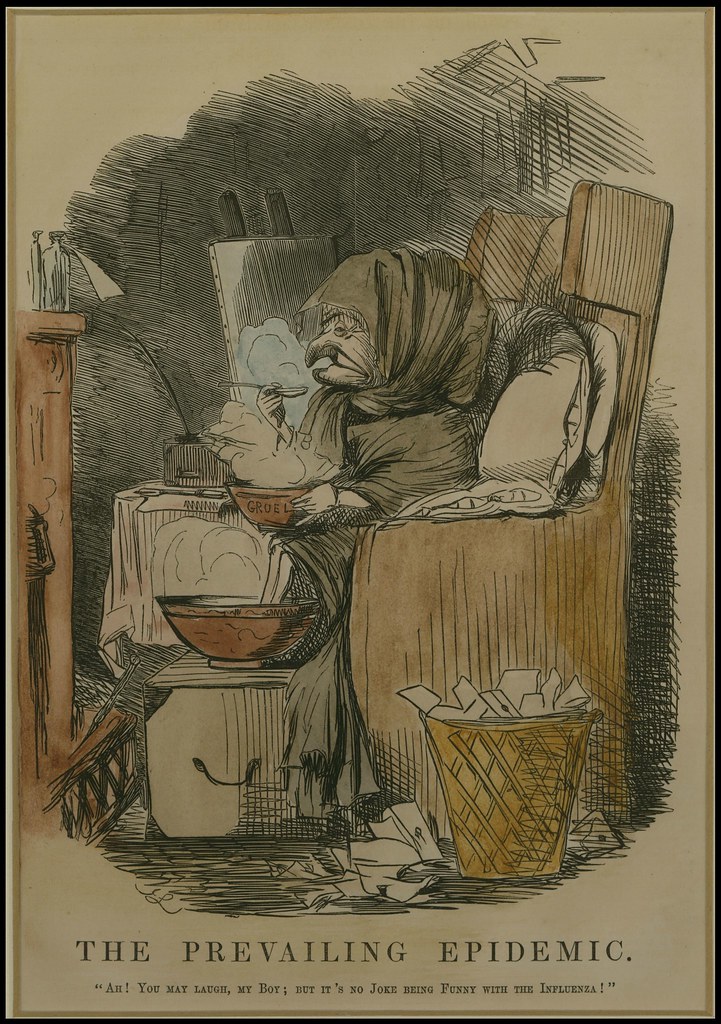
The Prevailing Epidemic
"Ah! you may laugh, my boy; but it's no joke being funny with the influenza!"
"Ah! you may laugh, my boy; but it's no joke being funny with the influenza!"
This print is recorded as anonymous at the source site, but I think the "JL" bottom left of the sketch (as well as the general illustration style) matches up well to the English caricaturist, John Leech, from the mid-1850s.
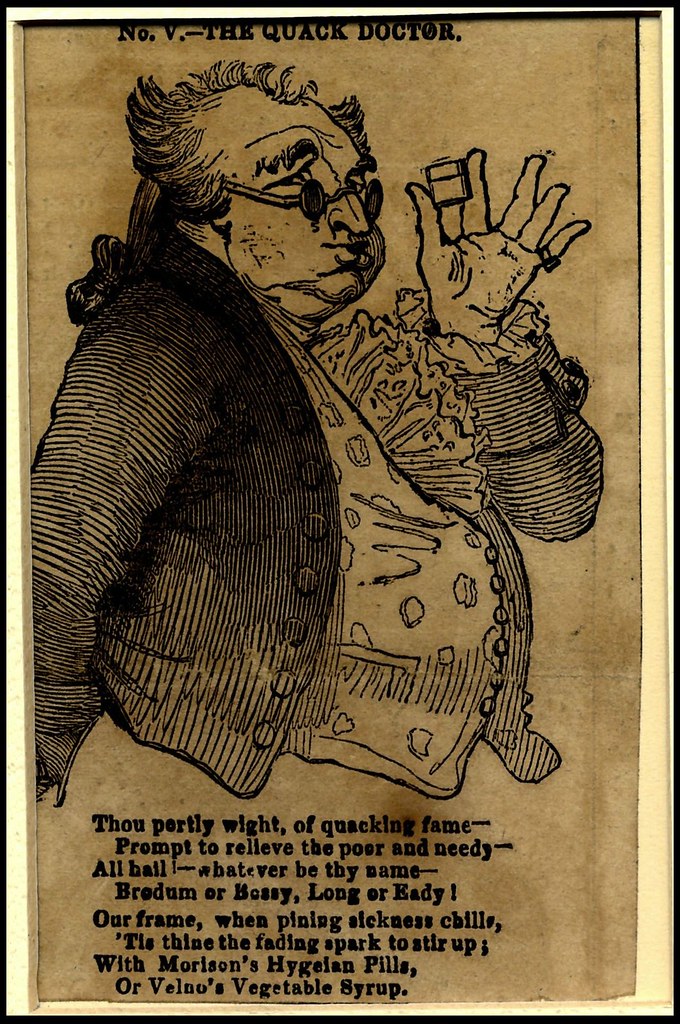
The Quack Doctor
Anonymous, date unknown (?late 18th, early 19th c.)
Anonymous, date unknown (?late 18th, early 19th c.)
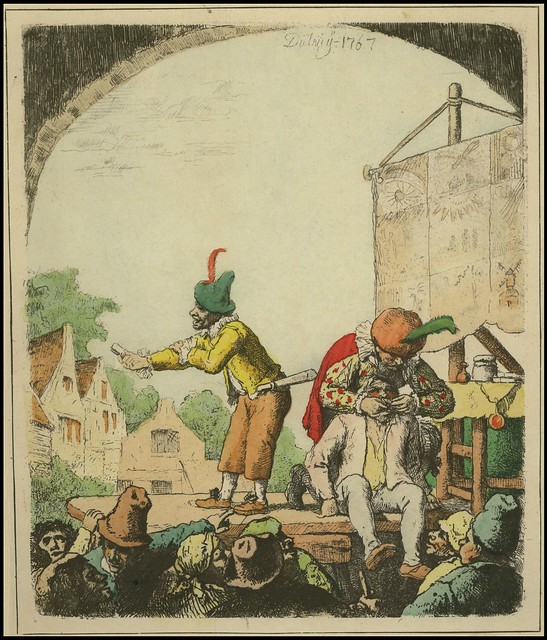
Toothpuller Entertaining in Public
Artist unknown, 1767
Artist unknown, 1767
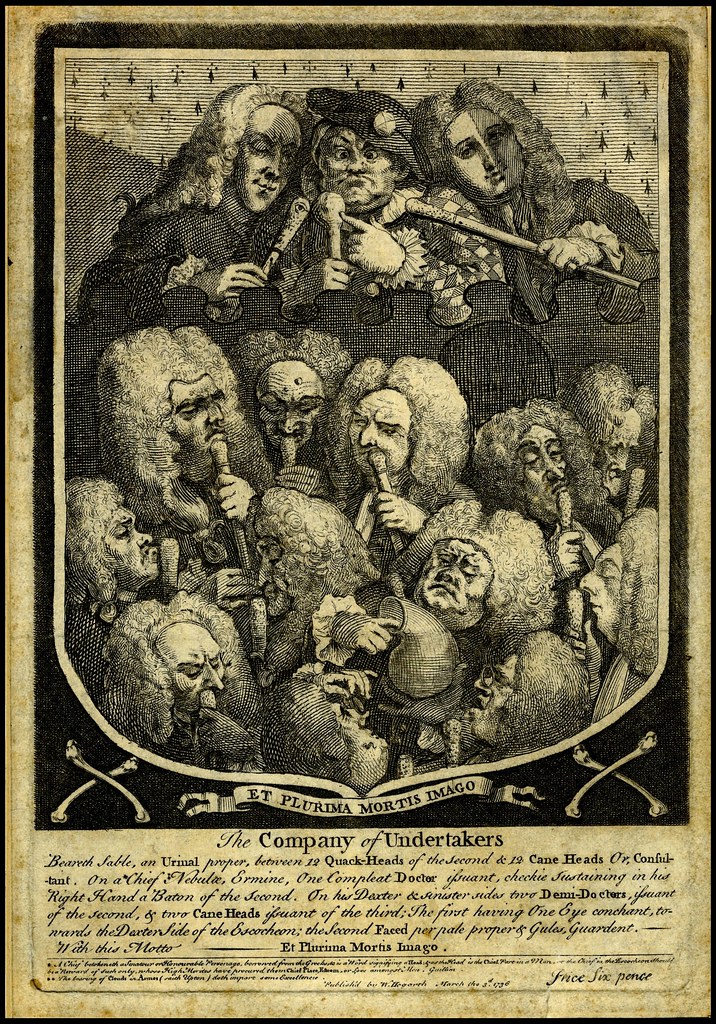
The Company of Undertakers
::: Beareth Sable, an Urinal proper, between 12 Quack-Heads of the second & 12 Cane Heads Or, Consultant. On a Chief Nebuloe, Ermine One Compleat Doctor issuant, checkie sustaining in his Right Hand a Baton of the second. On his Dexter and sinister sides two Demi-Doctors, issuant of the second, & two Cane-Heads issuant of the third; The first having One Eye conchant, towards the Dexter Side of the Esocheon; the Second Faced per pale proper & Gules, Guardent.
With this Motto - Et Plurima Mortis Imargo :::
Designed/engraved by William Hogarth, 1736
"[This is] Hogarth's delightful commentary upon the medical profession. Represented within a satirical coat-of-arms the engraving is bordered in black, like a mourning card. Beneath it are a pair of ominous crossbones and the motto, "Et Plurima mortis imago" -- 'And many an image of death'.Incidentally, a (much crisper/clearer) copy of this print was reissued later minus the text below the illustration, but bearing the title, 'Consultation of Physicians'.
The three major doctors inhabiting the upper portion of the coat-of-arms were based upon actual practitioners. In the centre of this trio is a figure dressed in a clown's suit which Hogarth refers to as "One Compleat Doctor". This figure was actually a woman named Sarah Mapp, a well known bone-setter. To her left is a feminine faced physician meant to portray Joshua Ward ('Spot Ward'), a doctor who had a birth-mark covering one side of his face. To her right, resides John Taylor, a well known oculist of the day. Taylor, it is reported, had only one eye. These physicians apparently lack the skills to heal themselves.
The lower portion of the coat-of-arms contains twelve more quack doctors. Most are occupied in sniffing the heads of their canes, which, in the eighteenth century, contained disinfectant. Three doctors, however, are absorbed by the contents of a urinal. Their expressions range from sour to unintelligent." [source]
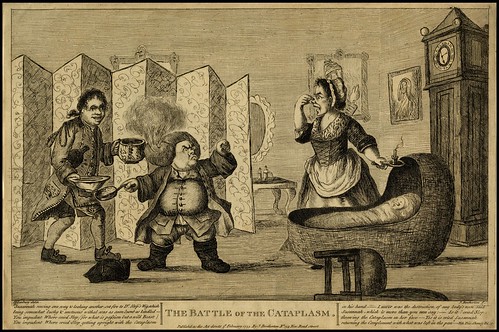
The Battle of the Cataplasm
Artist: JW Bunbury (pub'd by J Bretherton, 1773)
Artist: JW Bunbury (pub'd by J Bretherton, 1773)
"One of a series of illustrations to Laurence Sterne's 'The Life and Opinions of Tristram Shandy, Gentleman' showing Dr. Slop and Susannah exchanging abuse. Dr. Slop stands, with his wig burning, about to throw cataplasm* in Susannah's face. Susannah stands behind the cradle in which lies the infant Tristram, a plaster across his nose, as she holds her nose and a candle."*
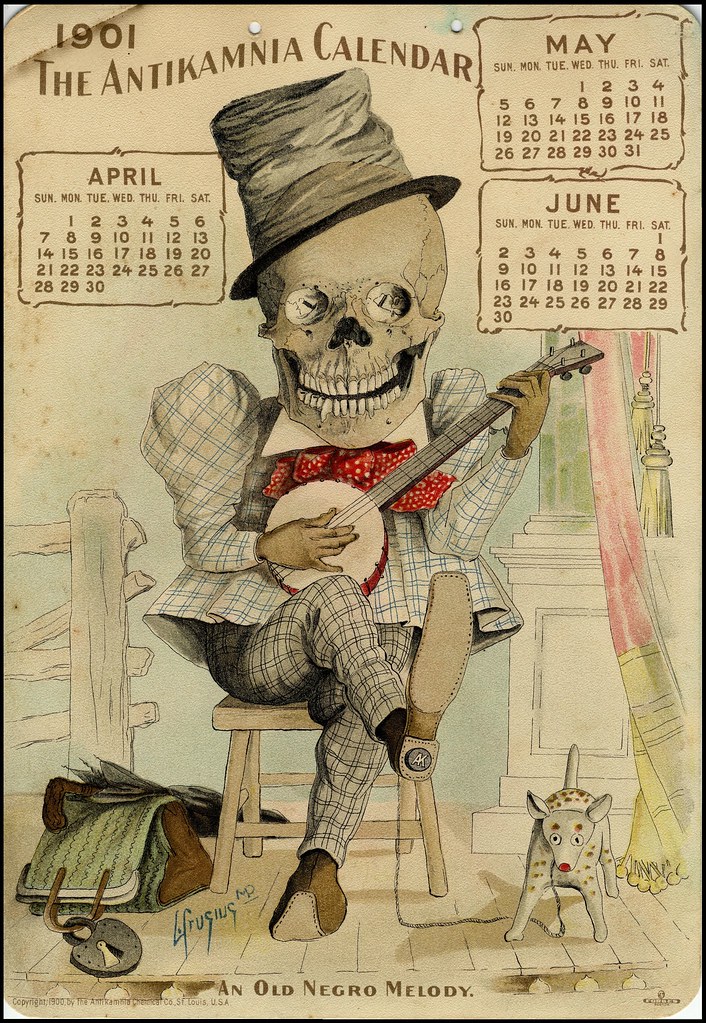
An Old Negro Melody
IN: The Antikamnia Chemical Company Calendar, April-June, 1901
IN: The Antikamnia Chemical Company Calendar, April-June, 1901
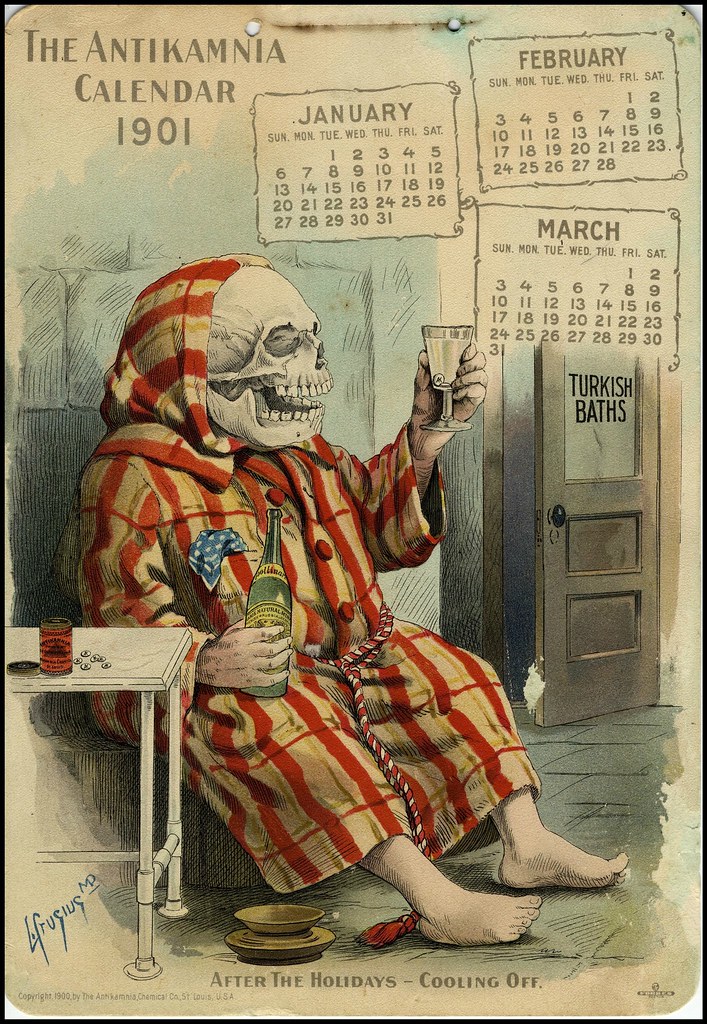
After the Holidays - Cooling Off
IN: The Antikamnia Chemical Company Calendar, Jan-March, 1901
IN: The Antikamnia Chemical Company Calendar, Jan-March, 1901
***See: The Antikamnia Chemical Company post on BibliOdyssey for many more related images and background.
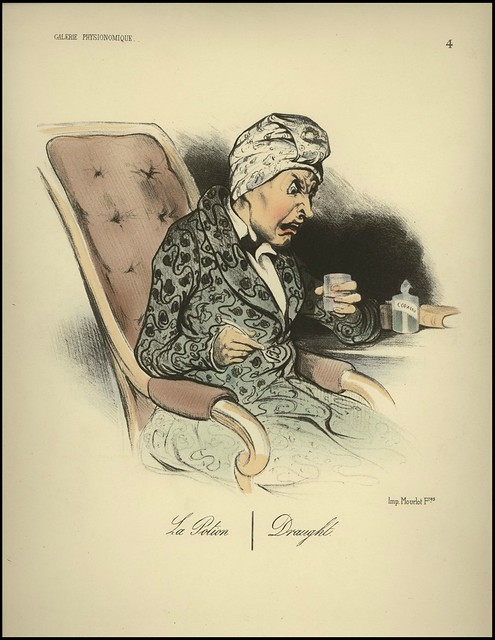
La Potion Draught
A man is taking a draft of Copaiba medicine for his cough.
IN: 'Le Charivari', November 1836 ('Galerie Physionomique') by Honoré Daumier
The 'Galerie Physionomique' was a series of 25 lithographs that appeared in 'Le Charivari' between Nov. 1836 and Dec. 1837.
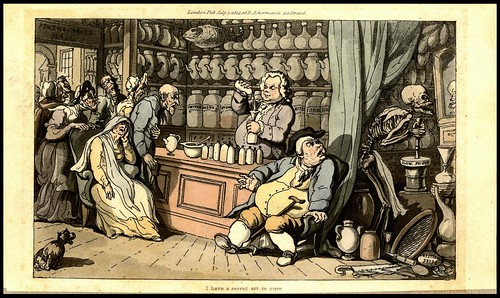
I Have a Secret Art to Cure [Each malady, which men endure]
Thomas Rowlandson's illustration from 1815 first appeared in the classic 2-vol. publication, 'The English Dance of Death'.

Gentle Emetic (by James Gillray, 1804)
"An emetic is a medicine that produces nausea and vomiting. “Puking” was considered to be another way to restore balance to the body. In this etching, a man and his physician [..] patiently wait for the effects of an emetic. The physician solicitously holds the man's head in his hands while the patient looks extremely uncomfortable. A bowl on the table awaits the contents of his stomach. The use of “gentle” in the title is definitely tongue-in-cheek." [source]

Gare la Vaccine
Triomphe de la Petite Verole
(Mind the Vaccine, Triumph of Smallpox)
Triomphe de la Petite Verole
(Mind the Vaccine, Triumph of Smallpox)
Vaccination had become quite widespread in France and England by the beginning of the 19th century and was energetically attacked by fearmongers in satirical pamphlets showing victims acquiring vaccine-host-animal qualities, for instance.

Breathing a Vein
Etched engraving by James Gillray 1804, published by H Humphrey, St James St. London
"Bloodletting, or phlebotomy, had been a standard medical practice since antiquity. It entailed withdrawing a considerable amount of blood from a person in order to cure disease. Blood was thought to build up in excess and then stagnate in certain areas of the body. Removing the extra blood would restore the natural balance of the body.
In this etching Gillray demonstrates venesection, which he calls “breathing a vein.” The title suggests that the procedure was a pleasant way to allow the vein a little air. The reality of the procedure was something else, as the cartoon suggests. A tourniquet was placed above the elbow, the artery in the forearm was punctured by a lancet, and the blood, gushing like a geyser, was captured in a bowl." [source]
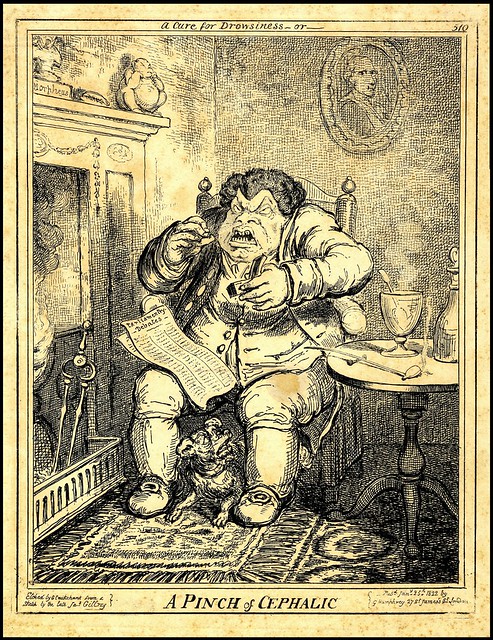
A Curse for Drowsiness -or- A Pinch of Cephalic
Engraving by George Cruikshank after a sketch by (the late) James Gillray and published by H Humphrey, St James St. London, 1822. [in colour]
A gouty old John Bull, seated with his brandy, water and pipe, takes a pinch of snuff.
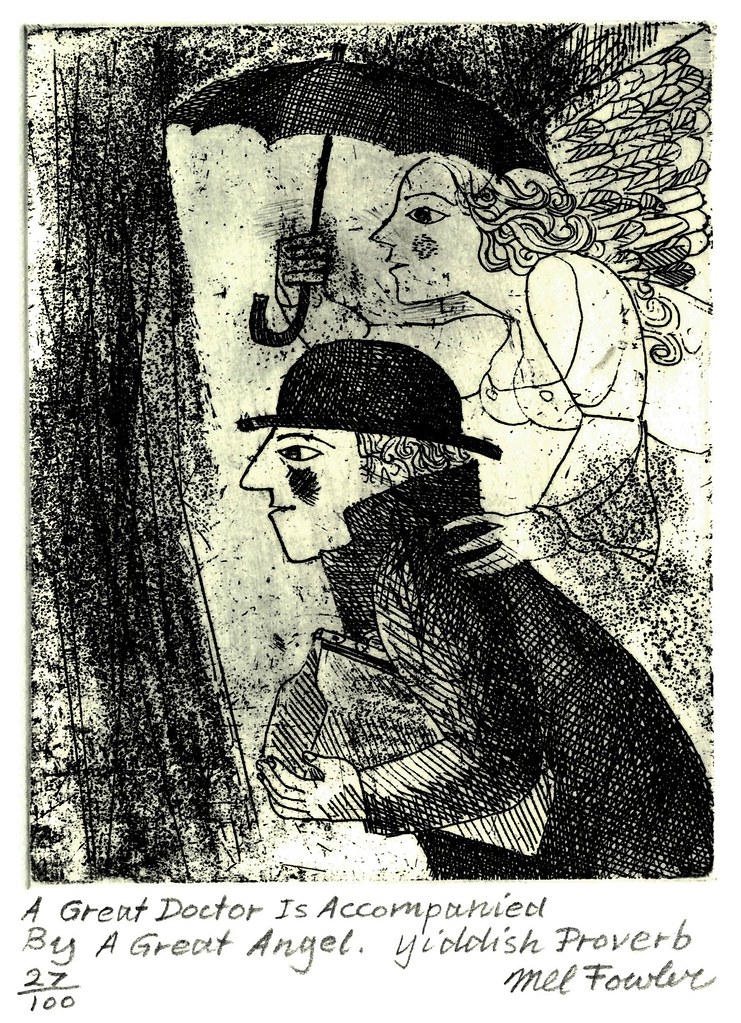
A Great Doctor is Accompanied by a Great Angel
[Mit a groissen roifeh gait a groisser malech]
Undated etching by Mel Fowler (d. 1987)*
[Mit a groissen roifeh gait a groisser malech]
Undated etching by Mel Fowler (d. 1987)*
Waring Historical Library at the Medical University of South Carolina offers up a collection of medical caricatures through the collaborative Lowcountry Digital Library.
- Previously: medicine; science.
- All the images above were spliced together from screen shots.
- Amazon: Thomas Rowlandson - George Cruikshank - James Gillray - William Hogarth.
Girls Swimming
Today's picture features a group of girls swimming. The picture was taken in 1925 at Arlington Beach. You can see the Washington Monument in the background. Yesterday's and todays pictures really remind me of summer camp. So do any of you all have fond (or otherwise) memories of summer camp? I went to summer camp with the Boy Scouts, and always thoroughly enjoyed it. I hope you will share your memories this week as we look at summer recreation from a bygone era.
Domestic Update:
 |
| Happy Orphans at the African Village of Mattaw |
I have been really enjoying keeping up with the work of the Lovely Miss EAM. For those of you new to the blog, she is my daughter. She just got her RN degree, and thanks in large part to the generosity of the good people on this blog, she is presently serving as the village nurse at the Mattaw Orphan Village in Africa. She is also coordinating their efforts to actually build a small medical clinic in the village.
To be honest with you though, I am finding myself extremely jealous of her. I was always the one with the most interesting travels and stories. Now, I fear she has surpassed me, and has become a true adventurer. Where she lives is pretty much the last outpost of civilization, and just to her north are the tribal regions and no-man lands of Africa. As she relays stories to me of what is happening in that part of the world, I become intrigued and would very much like to be a part of it.
So, Mrs. PJM and I have decided to take a little trip to Africa over Christmas to get a little taste of the adventure.
Canoes
Today's picture features a canoe rental stand in Arlington Beach park. The picture was taken in the 1920's. I have had lots of memorable times in canoes, and also some times I ended up tipping over. Any one else had any canoe adventures . . . please share them!
Morbid Anatomy Library Open Hours This Saturday, October 29

This Saturday October 29th, the Morbid Anatomy Library--pictured above--will have open hours from 1 until 6 PM. So feel free to drop in for a perusal of the stacks and to meet our newest addition.
For more about the Morbid Anatomy Library and for directions and other such information, click here.
Photo of The Library by Shannon Taggart
“Metaphor as Illness,” Lecture by Mark Dery, Embodied Fantasies Conference, Sunday October 30

Mark Dery, one of my favorite all time thinkers and lecturers, will be giving a new presentation this Sunday as part of the amazing looking Embodied Fantasies Conference. Full details, drawn for his Shovelware blog, below; hope to see you there!
Live, from the Cancer Ward!You can find out more about the conference and its schedule by clicking here.
I’ll be lecturing on “Metaphor as Illness” at the School of Visual Arts this Sunday, at 1:30 P.M., in a double-header with media theorist McKenzie Wark.
Executive Summary: A personal essay—live, from the cancer ward!—that is simultaneously a philosophical investigation into the ways in which disease widens the Cartesian chasm, untethering our thought balloons from the Body in Pain.
Directions, program, list of speakers, HERE.
Teaser: During my recent hospitalization for a medical emergency—an unexpected vacation in hell, during which I had boundless hours to muse about Illness as Metaphor and The Body in Pain—I conceived the essay in question, an essay that simply had to be written, as a meditation on language, embodiment, language as embodiment, and the ontologically dislocating experience of being a patient. Drawing on my five-year tour of duty through ER’s, OR’s, and hospital wards as a cancer patient, the lecture in question combines a cultural criticism reminiscent of Sontag’s Illness as Metaphor with the mordant humor of Christopher Hitchens’s recent reports on his battle with the Big C. It’s a philosophical inquiry into the existential black comedy of being a patient—Burton’s Melancholy of Anatomy , reimagined as an episode of the cynical medical drama House.
It’s also one of the best things I’ve ever written—a closely observed, unsparingly honest, emotionally raw self-anatomization that manages, even so, to be philosophically probing, I think.
Image: The Anatomy lesson of Dr Frederik Ruysch, Jan van Neck (lifted from Wikimedia Commons).
Morbid Anatomy Library on Fox News. Yes, Really.

A few weeks ago, Fox News (yes, THAT Fox News) sent over Red Eye host Bill Schulz and former medical examiner of New York Dr. Michael M. Baden for a little filmed visit to the Morbid Anatomy Library. In the course of our time together, we talked about phrenology, body snatching, and mummification. In addition, the very knowledgeable Dr. Baden conducted a thorough and pretty fascinating forensic examination of the newest addition to the library: an early 20th century human skeleton medical preparation, seen in the screen shot above.
You learn all about the skeleton--and watch the segment in its entirety--by clicking here.
Old Busses
Today's picture comes to us from 1913. It shows two buses in New York City. I love how the buses really look more like motorized train cars. Not sure what part of New York the picture is taken in.
Dreamland Destinations #5



Everytown - 1940, 1966 and 2036, (Things to Come, d. William Cameron Menzies, 1936)
Exhibition: "Mechanical Wonders: The Sandoz Collection," Through November 26, 2011

This exhibit looks truly amazing! Many of the objects, I am told, come only very rarely to The United States, so make sure to take advantage of this opportunity while you can! I will absolutely be making a personal pilgrimage.
"Mechanical Wonders: The Sandoz Collection"You can find out more and purchase tickets by clicking here. Thanks so much to the inspiring Jere Ryder for alerting me to this exhibition!
Presented by A La Vieille Russie and Parmigiani
October 26 – November 26, 2011
Visit ALVR this Fall to see a very special loan exhibition of intricate marvels that jump, sing and act as you never believed jeweled creations could.
Featuring early 19th century Swiss gold and enamel automaton snuff boxes, watches, magicians, and animals, the Imperial Swan Egg of 1906 and the Imperial Peacock Egg of 1908 by Fabergé, as well as contemporary interpretations by Parmigiani Fleurier of watches in the Sandoz Collection. In addition, the catalogue raisonné of the collection will be presented for the first time.
EXHIBITION HOURS (beginning October 26):
Monday through Friday 11am-6pm
Thursday 11am-7pm
Saturday 12pm-5pm
Closed for Thanksgiving Day.
Address: 781 Fifth Avenue at 59th Street
New York, NY 10022
212-752-1727
www.alvr.com
Labels:
automaton,
exhibition
Arnould Galopin

Quelle bonne idée ont eu les défricheurs de L'Arbre Vengeur (une maison dont on ne dira jamais assez de bien) d'aller repêcher Arnould Galopin (déjà, s'appeler comme ça c'est juste incroyable). Prolifique auteur de romans populaires en fascicules et d'oeuvres diverses et variées, le pauvre Arnould (1863-1934), malgré son nom, n'a pas creusé son sillon dans la mémoire collective... et pourtant. Ce simple texte, Le Bacille (1928), mérite vraiment une redécouverte enthousiaste.
 Il y est question de Martial Procas, un jeune et beau scientifique spécialiste de la bactériologie. Adulé par de nombreuses admiratrices qui viennent le reluquer pendant ses cours à la Sorbonne, la vie de Martial semble idyllique. Il tombe même amoureux de Meg, un belle américaine. Jusqu'au jour où (car il y a toujours un "jusqu'au jour où") il découvre que Meg le trompe et là... accrochez vous... il est foudroyé par une crise de cyanose, une asphyxie qui le transforme en monstre. Sa peau devient bleue et ses yeux jaunes! Imaginez le drame. Commence alors une vie de solitaire, de reclus. Son physique lui interdit tout rapport social. Les gens le fuient, l'insultent, le soupçonnent des pires méfaits. Seul un chien errant, Mami, vient lui apporter un peu de réconfort.
Il y est question de Martial Procas, un jeune et beau scientifique spécialiste de la bactériologie. Adulé par de nombreuses admiratrices qui viennent le reluquer pendant ses cours à la Sorbonne, la vie de Martial semble idyllique. Il tombe même amoureux de Meg, un belle américaine. Jusqu'au jour où (car il y a toujours un "jusqu'au jour où") il découvre que Meg le trompe et là... accrochez vous... il est foudroyé par une crise de cyanose, une asphyxie qui le transforme en monstre. Sa peau devient bleue et ses yeux jaunes! Imaginez le drame. Commence alors une vie de solitaire, de reclus. Son physique lui interdit tout rapport social. Les gens le fuient, l'insultent, le soupçonnent des pires méfaits. Seul un chien errant, Mami, vient lui apporter un peu de réconfort.Un beau jour (pas si beau que ça), un enfant disparaît dans le quartier... Rapidement, on soupçonne cet homme seul et repoussant, que l'on surnomme 'L'horreur', "ce monstre bleu, ridicule et sinistre, plus hideux qu'un masque japonais" (sa propre image dans le miroir). Les habitants, poussés par l'euphorie de groupe, s'acharnent à démontrer sa culpabilité. Le pauvre freak n'a plus qu'une seule solution face à l'opprobre et la médisance, une vengeance d'intellectuel, un coup, le terrorisme biologique!
Vous me ferez le plaisir de lire ce livre unique et mystérieux, hallucinante fable sur la violence sociale, le désir de notoriété, la différence et la solitude, matinée d'ambiances rappelant Franju ou Le Fantôme de l'Opéra. Une pépite, j'vous dis!!!
Editions l'Arbre vengeur. 2011. Illustrations de Hugues Micol.

Amazing Auction Alert: Bonhams "Objects of the Wunderkammer including an Exceptional Private Collection of European Ivories," London



Wow. Via Artdaily.org:
LONDON.- On Wednesday 2 November, to coincide with Halloween, Bonhams will hold its first sale dedicated to the Wunderkammer, also known as the ’Kunstkammer’ or ‘cabinet of curiosities’, a collection of fine objects created from the rarest and most exquisite materials and designed to induce excitement and wonder in the viewer.You can read the full article on Artdaily.org by clicking here. You can find out more about the auction by clicking here.
Comprising works of art ranging from ivory figures and reliefs, early and rare bronzes, fine enamels, chalices and caskets, the Wunderkammer brought together objects produced from the most expensive and highly prized materials of the day, including ivory, tortoiseshell, rhino horn, enamel and gilt bronze.
This unique, one-off sale features one hundred and thirty ivory carvings, including a very spooky South German skull (estimate £10,000 – 15,000); an eerie 17th century anatomical model of an eye (estimate £4,000 – 6,000); and a gruesome relief depicting the martyrdom of Saint Erasmus (estimate £10,000 – 15,000). The top lot is a rare collection of forty four mid 18th century ivory intaglios of Roman Emperors, which has attracted a pre-sale estimate of £20,000 – 30,000. ...
Images of lots, top to bottom:
1) Lot No: 225
An 18th / 19th century North European carved and painted wood skull
possibly from a large crucifixion group, 14cm high
Estimate: £500 - 700, € 580 - 810
2) A rare South German anatomical model of an eye
probably late 17th century
composed of ten individual sections including an iris, pupil, and a section painted with veins, with a turned handle to the reverse and on a turned ivory spiralling stem and foot, together with a small 17th century circular carved wood and painted box which the eye fits into when disassembled, glass lense repaired, the ivory 8.5cm high, the box 8cm diameter (2)
Estimate: £6,000 - 8,000, € 6,900 - 9,200
Footnote:
The exquisite workmanship combined with the use of a rare and prized material in this miniature model of a human eye are typical of the objects that were collected and displayed in the Wunderkammer. Detailed models of eyes, as well as skulls and skeletons that are now associated with the Wunderkammer, were produced from the 17th century onwards and originally conceived as anatomical teaching tools. Ivory carvers such as Stephan Zick (1639-1715) and Johann Martin Teuber were influenced by the anatomical drawings of Andrea Vesalius in the mid 16th century and later George Bartisch who produced a manuscript relating to the eye in 1583. For a similar anatomical model of an eye, see Christies, London, December 4 2008, lot 75.
3) Lot No: 174Y
An 18th century South German ivory skull
carved with an entwined crown of thorns, with a snake above, later mounted on a perspex rectangular plinth, the ivory 10.5cm high
Estimate: £10,000 - 15,000, € 11,000 - 17,000
Footnote:
For a comparable ivory skull see the Robert and Angelique Noortman Collection: Paintings and Works of Art from Chateau De Groote Mot, sold at Sotheby's, Amsterdam, December 17, 2007, lot 557.
A similar skull monogrammed by Josef Konrad Wiser (1693-1760) but lacking the snake was sold at Sotheby's, London, July 9, 2008, lot 92, £37,250.
Labels:
auction,
wunderkammer
Sleeping in Bus Terminal
Today's picture was taken in 1943, and it shows a woman sleeping in a bus station in Chicago, Illinois. I have never slept in a bus station, but I have slept in airports. By airport standards, this couch looks very comfy. In airports you just have chairs, and have to scoot down in the chair far enough to rest your head on the backrest. Not comfortable at all. Have any of you slept in a bus station or airport?
Pushkin Silhouettes











A collection of silhouette illustrations relating to Russian poet, Alexander Pushkin, was published in 1949. The images above were cropped from the full page layouts posted to the da_zdra_per_m LJ site. {if you click through on an image and then "В другом размере", you can view enlarged versions}.
The Russian Silhouette Museum advises that the book includes illustration works by a number of artists, including "V.Gel'mersen, N.Il'in, B.Kustodiev".
Previously: The Silhouette Book || van Geldorp || literature || Russia.
Crowded Bus Terminal
Today's picture comes from 1943, and shows a crowded bus terminal. The picture was taken in Memphis, Tennessee. I like looking at all the individuals in the crowd.
Subscribe to:
Posts (Atom)






